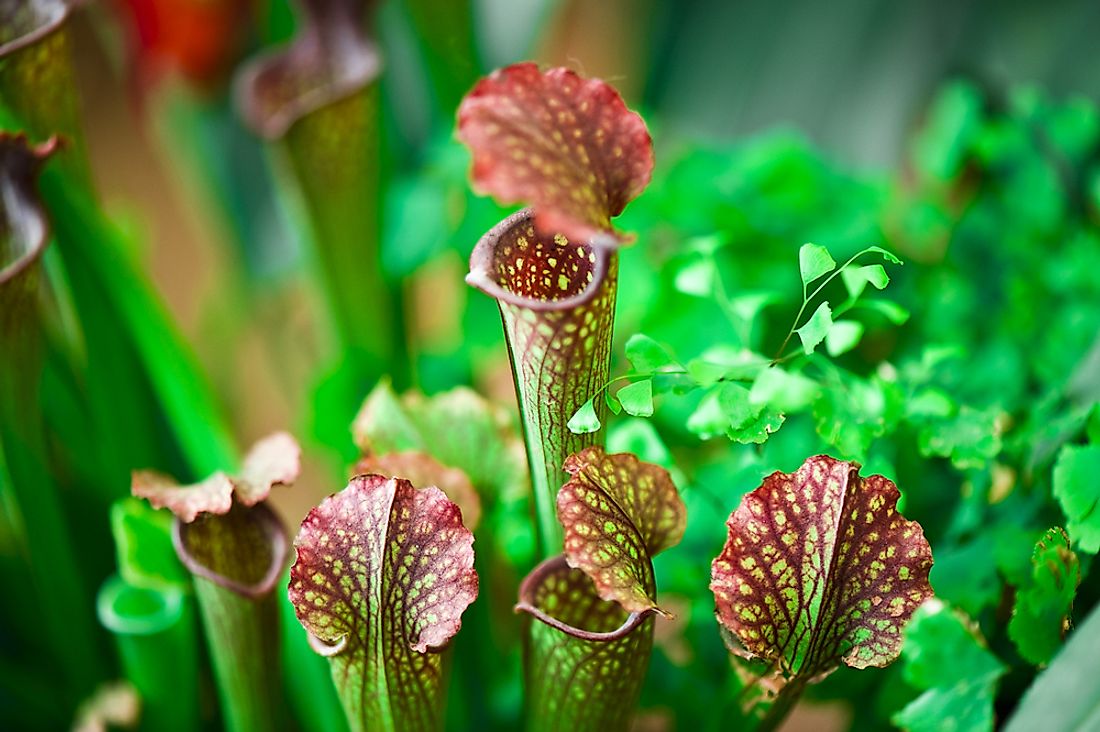What is a Carnivorous Plant?

Carnivorous plants are uniquely adapted to environments that have poor nutrients. To supplement the low nutrients that they get from the environment, carnivorous plants trap and digest invertebrates, commonly insects or small vertebrates, These plants are often referred to as insectivorous since the majority of their prey is insects. The number of existing carnivorous plants is known to be about 583 species. The carnivorous plants have different trapping mechanisms including pitfall traps in pitcher plants, flypaper that uses sticky mucilage, snap traps using leaf movements, bladder traps sucking in prey, and lobster traps forces prey towards a digestive organ. Below is an analysis of some carnivorous plants.
three examples
Trumpet Pitchers - Sarracenia
Trumpet Pitchers, scientifically known as Sarracenia, are a genus of about 8-11 species of carnivorous plants that are indigenous to North America. They are predominantly located in Texas, the easter seaboard of the United States, the Great Lakes, and Southeastern Canada. The leaves of these plants are funnel shaped which allow them to trap insects. The pitcher plant is adapted for its feeding methods as it has colourful flowers that produce nectar and have an attractive scent. When an insect lands on the slippery footing on the pitcher’s rim, it quickly falls inside where it is trapped which leads to its death. When they die the insects are digested by enzyme proteases.
Tropical Pitcher Plant - Nepenthes Truncata
The tropical pitcher is genus of carnivorous plants that are scientifically known as Nepenthes truncata from the family Nepenthaceae. The plant grows in highly humid environments ranging from South China, Malaysia, Indonesia, the Philippines, Madagascar, Seychelles, and Australia. The majority of the species are found in Borneo, Philippines, and Sumatra. The Nepenthes genus has approximately 150 species and many hybrids. This plant has a pitcher that begins as a small bud and gradually grows into a tube-shaped trap which contains syrup that drowns the prey. Once the insect is trapped, it will be difficult for it to escape as the waxy coating on the upper inside traps it. The majority of their prey is insects although larger species catch vertebrates like lizards and rats.
Butterworts - Pinguicula
Butterworts is a genus of carnivorous plants that is scientifically referred to as Pinguicula and is native to Central America. The Pinguicula has sticky leaves that attract, trap, and digest insects that they use to supplement the deficient nutrients from the environment. There are roughly 80 known species of butterworts with 12 indigenous to Europe, 9 to North America, and some native to northern Asia. The butterworts are of two types depending on the climate that it inhabits which is either tropical or temperate. The Pinguicula is diverse in the northern hemisphere with a large concentration of its species in the humid and mountainous regions of Central and South America. This carnivorous plant grows in the alkaline soil that has poor nutrients.
Conclusion
Carnivorous plants are fascinating to look at even when they are not trapping insects which has led to many people collecting them in their natural habitat to plant in their homes. It is through this method as well as habitat loss that pose a serious conservation threat to the plants. Collections of these plants should be prohibited because they are so rare.
What is a Carnivorous Plant?
| Rank | Common Name | Scientific Classification | Type |
|---|---|---|---|
| 1 | Trumpet Pitchers | Sarracenia | Pitfall trap |
| 2 | Cobra plant | Darlingtonia californica | Pitfall trap |
| 3 | Australian pitcher plant | Cephalotus follicularis | Pitfall trap |
| 4 | Tropical pitcher plant | Nepenthes truncata | Pitfall trap |
| 5 | Sun pitchers | Heliamphora | Pitfall trap |
| 6 | Parrot Pitcherplant | Sarracenia psittacina | Pitfall trap |
| 7 | Hooded pitcher plant | Sarracenia minor | Pitfall trap |
| 8 | Fanged pitcher plant | Nepenthes bicalcarata | Pitfall trap |
| 9 | Yellow pitcherplant | Sarracenia flava | Pitfall trap |
| 10 | Butterworts | Pinguicula | Flypaper trap |
| 11 | Sundews | Drosera | Flypaper trap |
| 12 | Dewy pine | Drosophyllum | Flypaper trap |
| 13 | Venus flytrap | Dionaea muscipula | Snap trap |
| 14 | Waterwheel plant | Aldrovanda vesiculosa | Snap trap |
| 15 | Bladderworts | Utricularia | Bladder traps |
| 16 | Corkscrew | Genlisea | Lobster-pot traps |











